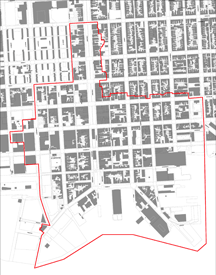Fells Point
National Register of Historic Places 3/28/69; expanded 1986.
Certified Historic District for Tax Incentives (NR)
National Register Map (map located directly to the right)
CHAP Historic District Map (map located below, map on top)
 Description
Description
The Fells Point Historic District comprises the waterfront of Fells Point with boundaries of Aliceanna Street, Dallas Street, and Wolfe Street on the north, west, and east, respectively. It is only a small portion of the larger area which is commonly called Fells Point, but it takes in the Market Square, Recreation Pier, South Shed of the Broadway Market, large waterfront warehouses, and Fells grave site. The district comprises some twelve city blocks along a strict grid pattern, broken only by diagonal waterfront streets.
 Broadway is the widest street within the historic district and encompasses the market and square. It is a commercial street with many original and replicated storefronts. The residential architecture of Fells Point features rowhousing from the eighteenth century to the early twentieth century. The earliest houses are of Flemish bond brick construction. There are many 2 ½ and 3 ½ story gabled roof houses with dormers. Other housing types from the Victorian era are scattered throughout the district. Residential, commercial, and industrial buildings are interspersed within this working waterfront neighborhood. Some of the warehouse buildings are immense brick structures on the waterfront, many of which have been proposed for adaptive re-use as housing.
Broadway is the widest street within the historic district and encompasses the market and square. It is a commercial street with many original and replicated storefronts. The residential architecture of Fells Point features rowhousing from the eighteenth century to the early twentieth century. The earliest houses are of Flemish bond brick construction. There are many 2 ½ and 3 ½ story gabled roof houses with dormers. Other housing types from the Victorian era are scattered throughout the district. Residential, commercial, and industrial buildings are interspersed within this working waterfront neighborhood. Some of the warehouse buildings are immense brick structures on the waterfront, many of which have been proposed for adaptive re-use as housing.
Significance
Fells Point is significant as one of the original three settlements that merged to form the beginnings of Baltimore City. The area is directly linked to early maritime trade, which was to Baltimore's growth and development. Many of Baltimore's famed Clipper Ships were built and operated out of Fells Point. They gained prominence by capturing and sinking British warships in the War of 1812. The maritime character of the district still exists with the small gabled roof residences that housed local seamen, ship's carpenters, sailmakers, and artisans.
The early built environment of Fells Point has and will continue to yield information concerning the eighteenth century character of early Baltimore settlements. The Robert Long house on Ann Street within the district dates from the 1760s, the oldest urban house in Baltimore City. Besides the significance of Fells Point in the eighteenth century, the community has been a constantly growing and changing urban place. Many of the earliest houses were added on to in the Victorian era creating a unique blend of pre-Revolutionary War and post-Civil War architectural styles and characteristics.
Fells Point has been a diverse neighborhood of many ethnic groups each influencing the growth and development of the area throughout the nineteenth and twentieth centuries. Many of the later structures are of architectural significance and are consistent with the waterfront character of Fells Point, even if stylistically different. Recreation Pier is an example of this type of significant structure in Fells Point.
 Description
Description